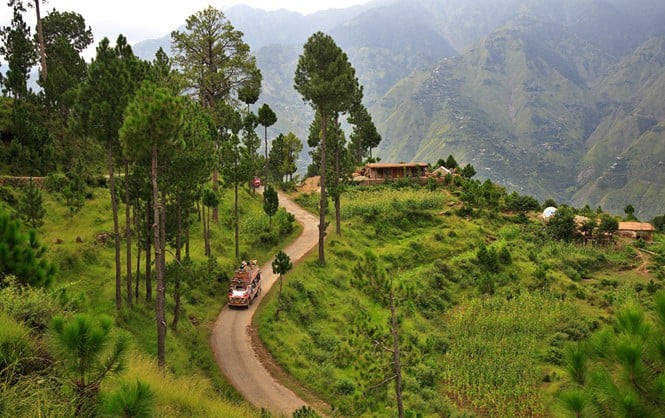
The tourism department lacks the capacity to cater to the rising inflow of tourists in the valley

Local tourism is one of the fastest-growing sectors in Azad Jammu and Kashmir, which has generated many employment and business opportunities during the past few years.
Hundreds and thousands of people from Karachi to Islamabad turn to the picturesque peaks of the Neelum Valley and Rawalakot when high temperature hits the plains of Sindh and Punjab, particularly during the months from May to August.
Over the years, a huge number of new hotels, guest houses, and small picnic points are being established by the local community in various regions of AJK, to cater to the requirements of tourists. A large number of residential houses have been turned into guest houses to get the benefits of unprecedented tourist influx in the region.
According to official sources, tourist inflow is steadily swelling in the area. In 2010, nearly half a million tourists visited AJK while in 2016 figures crossed one and a half million, which is an incredible development in the context of AJK where the tourism sector has largely remained a neglected area in the past.
Therefore, the current government seems to have taken note of the economic potential of tourism industry and made it their developmental priority, after roads and hydropower generation.
In order to develop the tourism sector in an effective way, the AJK government has launched an ambitious project -- the 190 km-long tourism corridor -- which will connect four districts. The proposed project’s estimated cost is about Rs22 billion. Prime Minister Nawaz Sharif had promised to provide eight billion rupees to kick off this project while the Prime Minister of AJK, Raja Farooq Haider Khan, invited the private sector, particularly overseas Kashmiris, to invest in the tourism corridor in view of the emerging business opportunities in the region.
Read also: The road to Kalam
The AJK government sources say this project might become part of the China-Pakistan Economic Corridor (CPEC) soon as discussions are underway between the governments of Pakistan and Azad Kashmir in this regard.
In Neelum Valley, the Line of Control (LoC) itself became a ‘tourist spot’ as thousands of people from all across Pakistan witnessed the Kashmiris’ plight while travelling through the Valley.
A number of new tourism operators have set up companies in recent years for groups in the area. They use websites, blogs, and social media to attract customers.
Proximity with Islamabad gives an exceptional advantage to AJK’s tourist resorts over other Northern destinations. Muzaffarabad, Neelum Valley, Rawalakot, Tolipeer, Chikkar, Sudhangali, Ganga Choti and Banjosa Lake, all places are well-connected with Rawalpindi and Islamabad, and are located at a short distance from these twin cities.
The post-earthquake rehabilitation and rebuilding process had given a new and better look to Neelum Valley, Bagh and Rawalakot districts. A huge sum of funds was spent in these areas to build road networks, schools, hospitals, and government offices.
During the last five years, over 312 guest houses have been constructed in the Neelum Valley which, just a decade ago, was considered a remote and underdeveloped region. Nearly 203 kilometres long road from Muzaffarabad to Taubutt, the last settlement of Neelum Valley, was turned into a picnic point.
At the edge of River Neelum, known as Kishanganga in the Indian-Occupied Kashmir, many small shops, hotels and restaurants have popped up. Likewise, over 225 guest houses were built in recent years with reasonable facilities and they charge modest rates for services and transport from Rawalakot city to Tolipeer which is located at a height of 8800 ft above the sea level.
Besides, numerous hotels and guest houses are being built to cater to the fast growing needs of accommodation and food of the tourists. Local businessmen and those working in the Gulf States are also investing in this sector.
In view of this, a non-governmental organisation recently conducted a skill development training for local people in Rawalakot where over 20 female candidates turned up to obtain a four-week long training certificate for cooking, reception management, and tour guide.
Although AJK’s primary workforce is engaged in businesses and jobs either in the Middle East or Europe, they cannot invite their foreign friends and business partners to visit their homeland due to numerous hurdles like the complications in obtaining a No Objection Certificate (NoC), which is required of the foreigners to enter AJK.
The government of AJK has been pleading before the Federal Ministry of Interior to either devise a quick and convenient process of obtaining the NoC for foreign visitors or authorise the AJK government to issue the certificate on its own, but to no avail.
Another problem which destroys the tourism prospects in the area is frequent exchange of fire along the Line of Control (LoC). Peace along the LoC is imperative to sustaining the present boom in the tourism sector and bringing investment in the region for the construction of required infrastructure, particularly in the Neelum Valley.
The tourism department also lacks the capacity to handle the inflow of tourists in AJK. The department has, so far, not been able to develop a reasonable web portal, booklets, and tourist guide maps to help and guide tourists.
Last but not the least, there is no understanding of the underlying link between environmental conditions and tourist traffic. Authorities in both Neelum Valley and Rawalakot have failed to start a garbage disposal system. One can find wrappers spread all around the picnic points.